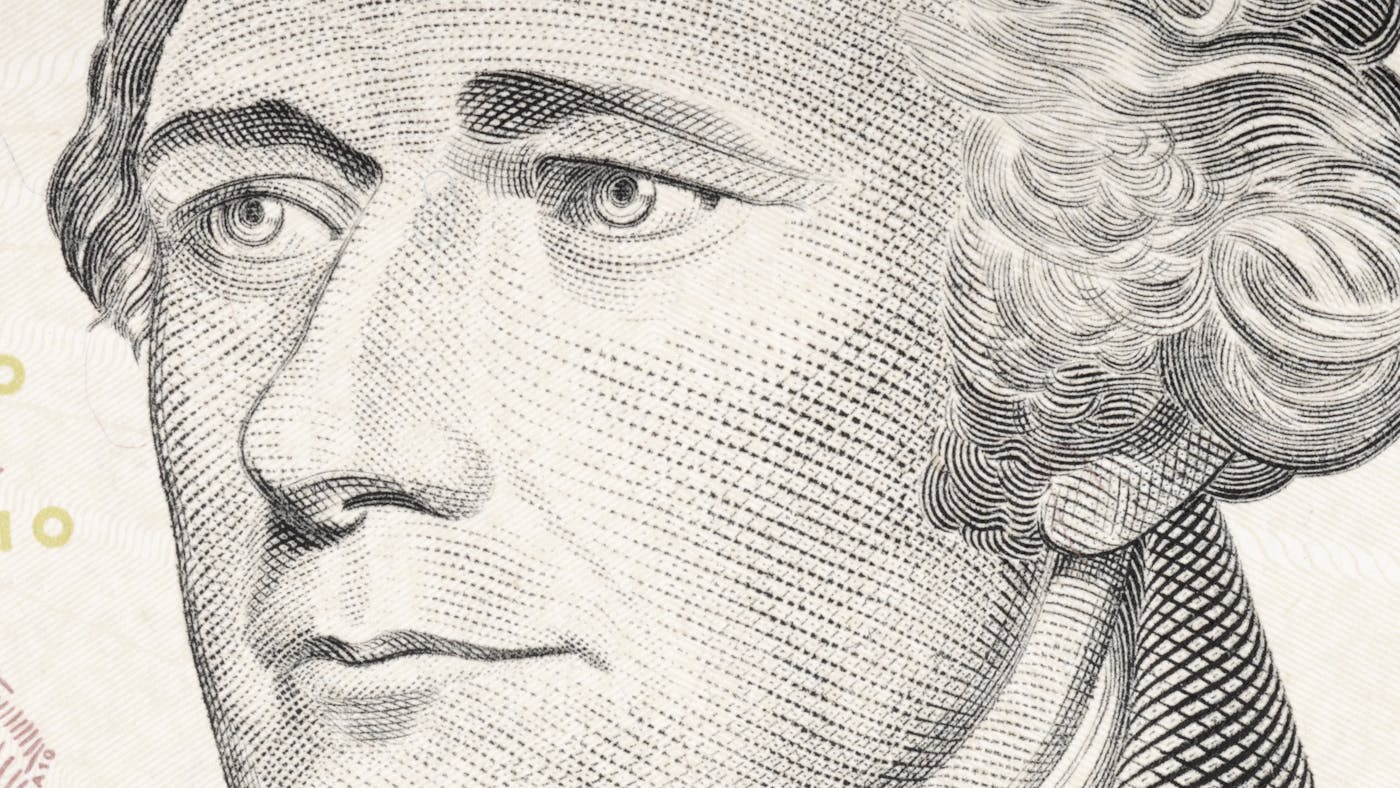American Prodigal
The Rise, Fall, and Redemption of Alexander Hamilton

Justice shall be done to the memory of my Hamilton.
According to her daughter, this was the compounding yearning of Eliza Hamilton in the fifty years she survived her husband, after his tragic, and dishonorable, death in an “affair of honor.” In the summer of 1804, he took a duel with Aaron Burr Jr., the sitting Vice President and grandson of Jonathan Edwards. Alexander Hamilton, citing Christian conviction, “threw away his shot” by not firing at his opponent. Burr, however, took aim and struck his political rival. Hamilton died 31 hours later on July 12, 1804.
Not only had the controversial circumstances of his death tarnished her Hamilton’s reputation, but so too had an another “affair” made public in 1797. And after Hamilton’s death in 1804, rivals John Adams and Thomas Jefferson both lived another 22 years to strengthen their own founding legacies, and bury Hamilton’s.
Justice Done to Hamilton?
Remarkably, Ron Chernow’s 800-page biography in 2004 — some 150 years after Eliza’s death in 1854 — began the work of doing justice to Hamilton’s memory in the twenty-first century. More than a decade later, Lin-Manuel Miranda’s musical, inspired by the biography, and with Chernow as historical consultant, sent Hamilton skyrocketing back into broader American awareness — just in time to save his face on the ten-dollar bill.
Of Christian interest, Hamilton appeared to have experienced a remarkable conversion, under Reformed teaching, as a teen when the Great Awakening came to his native West Indies in the early 1770s. Presbyterian minister Hugh Knox, who had studied at the College of New Jersey (where Edwards had been president briefly in 1758) mentored the 17-year-old Hamilton. When a hurricane passed through the Caribbean in August of 1772, Hamilton wrote markedly Christian reflections on the event. Knox read them and, impressed with the teen’s ability, guided them to press in the local paper. Enough readers took notice of the words from “a Youth of this Island” that it became an occasion for Knox to raise money to send Hamilton to New Jersey to study.
Journey into a Far Country
Hamilton soon left the West Indies, never to return, and arrived in New Jersey as the revolutionary spirit was fomenting. With his unusually able brain and pen, he was swept up into the Revolution and found himself at the heart of American politics from 1775–1800, perhaps surpassed only by George Washington in that quarter century. His Christian interests, however, seemed to cool as they were eclipsed by political ambition and zeal for his work as Washington’s aide-de-camp, then in establishing a law practice in New York, and climactically as the nation’s first Secretary of the Treasury from 1789–1795. Alongside James Madison, Hamilton proved to be one of the great intellects of the founding generation. And while being every bit Madison’s match in political thought (if not exceeding him), Hamilton far surpassed Madison, and the other leading founders, in economics.
Yet in his late forties, before dying in the infamous duel at age 49, Hamilton experienced a succession of great humblings, which appear to have prompted him, doubtless with the encouragement of his enduringly faithful evangelical wife, to blow again on the embers of the Christianity of his youth. Chernow, for one, recognizes that Hamilton’s late-life preoccupation “with spiritual matters . . . eliminates all doubt about the sincerity of his late-flowering religious interests” (707).
As the United States celebrates 246 years of independence, and Americans newly remember the ten-dollar founding father, what might Christians learn from the rise and fall, and redemption, of the “wandering and reticent” Alexander Hamilton?
Hamilton’s Tragic Success
Politically speaking, we could identify many important insights from a recovery of Hamilton’s legacy, but far more important, as Christians, whether American or not, is learning from his spiritual journey into the far country. And these are not the kind of lessons we might glean even from a man who professed, say, deism or atheism throughout his life. Rather, Hamilton, by all accounts, evidenced a vibrant Christian faith in his teens and gave clear affirmations of faith in Christ on his deathbed. However, sadly, he was a prodigal of sorts — captured by politics and establishing himself in the world — for much of his twenties and thirties. His meteoric rise to political power appears to have eclipsed the fires of his fledgling teenage faith. Yet he did, it seems, come to himself, once humbled, and eventually return home seeking the arms of a Father.
His Early Faith
His 1772 published letter that proved to be his way out of the West Indies “viewed the hurricane as a divine rebuke to human vanity and pomposity” (Chernow, 37). The storm thundered, according to the 17-year-old Hamilton, “Despise thyself and adore thy God.” Yet Hamilton, in his faith, found safety.
See thy wretched helpless state, and learn to know thyself. Learn to know thy best support. Despise thyself, and adore thy God. . . . [W]hat have I to dread? My staff can never be broken — in Omnipotence I trusted. . . . He who gave the winds to blow, and the lightnings to rage — even him have I always loved and served. His precepts have I observed. His commandments have I obeyed — and his perfections have I adored.
That same year, he wrote a Christian hymn, one that Eliza would come to prize and cling to during the half century she outlived him. There he confessed, “O Lamb of God! thrice gracious Lord / Now, now I feel how true thy word.”
His Meteoric Rise — and Fall
However, his way with words was soon put to other purposes. Once in America, his wordsmithing would propel him into revolutionary leadership, then to Washington’s side, and eventually to the most powerful seat in the first executive administration from 1789 until 1795.
Hamilton’s long-standing relationship with Washington proved to be a stabilizing force. In hindsight, his most productive (and least self-destructive) work came when he was most proximate to Washington, leading to the first of four lessons.
1. The right relationships can provide wonderfully fruitful restraints.
Chernow observes, “After Alexander Hamilton left the Treasury Department [in 1795], he lost the strong, restraining hand of George Washington and the invaluable sense of tact and proportion that went with it.” Washington was magnanimous. Few were willing to stomach such personal offenses as he endured without retaliating. The fatherless and insecure Hamilton badly needed this stabilizing presence. “Hamilton had been forced, as Washington’s representative, to take on some of his decorum. Now that he was no longer subordinate to Washington, Hamilton was even quicker to perceive threats, issue challenges, and take a high-handed tone in controversies. Some vital layer of inhibition disappeared” (Chernow, 488).
But it was not only Washington, whose guidance was political, but also Eliza, whose influence was gently but relentlessly spiritual. “As a woman of deep spirituality, Eliza believed firmly in [Christian] instruction for her children,” and it would prove to have effects on her husband as they raised them together, and particularly as his great humblings came in late 1799, throughout 1800, and into 1801. She endured his wandering and, in the end, it appears, won him with her life and conduct (1 Peter 3:1).
2. Ambition to make one’s way in the world can cool the fires of young faith.
In the Parable of the Sower, Jesus tells about seed sown among thorns: “They are those who hear the word, but the cares of the world and the deceitfulness of riches and the desires for other things enter in and choke the word, and it proves unfruitful” (Mark 4:18–19).
“Ambition to make one’s way in the world can cool the fires of young faith.”
Hamilton, admirably, was not undone by the deceitfulness of riches — his financial integrity was sterling — but “the cares of the world” and “desires for other things” haunted his extended season of spiritual reticence (from his seeming indifference to Christianity from 1777 to 1792, to his opportunist use of it for party purposes until 1801). Fatherless since age 10, and orphaned at 14, Hamilton seemed bent on proving himself in his new country. The flame and striking warmth of his teenage faith cooled as “cares of this world” began to energize him — first the Revolution, then becoming a respected New York lawyer, then rescuing the fledgling nation from its inadequate Articles of Confederation, and finally trying to preserve his power once Washington left office.
Such a story is not his alone. Countless Christian youths, flames burning bright, have found themselves crashing on the hard rocks, and hard knocks, of adult life. How might it have been different? That leads to a third lesson.
3. Faith does not thrive (and may not survive) apart from the church.
Chernow notes that “Hamilton had been devout when younger, but he seemed more skeptical about organized religion during the Revolution” (132). Perhaps circumstances from his childhood, and particularly his mother’s death, “help to explain a mystifying ambivalence that Hamilton always felt about regular church attendance, despite a pronounced religious bent” (25). Recently, historian and pastor Obbie Tyler Todd has written that Hamilton, from his arrival in America, was a man torn between two denominations (Presbyterian and Episcopal) “while finding no real home in the communion of believers.”
In Hamilton’s case, the ominous absence of the church may be the clearest warning sign we can point to. At 17, Hamilton seemed to thrive under Hugh Knox’s pastoral influence. But without the strengthening and constraining influence of a local church, a faithful evangelical wife was not enough to keep him from wandering, even if she would be vital to his late-life renewal.
4. We can be most vulnerable when we feel strongest.
Hamilton’s 1791 adulterous affair with Maria Reynolds showed how far he had wandered — and reminds us of the delusion of power and success. There once was a great king in Israel who, as a prelude to infidelity, remained in the city when others went to war (2 Samuel 11:1). So too the 36-year-old Hamilton, at the height of his power — and with so much work to do — stayed in New York while his family summered upstate.
That summer a 23-year-old woman approached him telling of an abusive husband and asking for help. Later, in the notorious Reynolds Pamphlet, his extended public confession in 1797, written to vindicate his financial reputation, he would write that he came to her door with monetary assistance and, “Some conversation ensued from which it was quickly apparent that other than pecuniary consolation would be acceptable.” This is the first of several 1790s instances about which Chernow, even as the cool-headed biographer, appears stunned by Hamilton’s folly:
Such stellar success might have bred an intoxicating sense of invincibility. But his vigorous reign had also made him the enfant terrible of the early republic, and a substantial minority of the country was mobilized against him. This should have made him especially watchful of his reputation. Instead, in one of history’s most mystifying cases of bad judgment, he entered into a sordid affair with a married woman named Maria Reynolds that, if it did not blacken his name forever, certainly sullied it. From the lofty heights of statesmanship, Hamilton fell back into something reminiscent of the squalid world of his West Indian boyhood. (362)
For Christians, the stakes are far greater than political reputation. Hamilton knew better — not only as a man and stateman, but as one who had professed faith in Christ. Perhaps he thought, for six years, that he had gotten away with it (politically speaking), with only the checks it took to pay off her husband’s blackmail. But the whispers were proclaimed from rooftops in 1797 and threatened not only to undo his future prospects, but also his past work.
Quiet Uptown: His Redemption
The late Adams administration held one humbling after another. Adams broke from his cabinet (and Hamilton) and sought peace with France in October of 1799. Two months later, Washington died suddenly. By February 1801, it became clear the Federalist party was turning from Hamilton to Adams. Then, by the end of April, Burr and his opposing coalition won control of New York. In a matter of months, Hamilton’s political power and influence crumbled.
To top it all off, in the election of 1800, his old cabinet rival Jefferson won the presidency — and with Burr as vice president. As Douglass Adair and Marvin Harvey wrote in 1955, “Perhaps never in all American political history has there been a fall from power so rapid, so complete, so final as Hamilton’s in the period from October, 1799 to November, 1800” (“Was Alexander Hamilton a Christian Statesman?” 322). Devasted, he began to consider again the God of his youth. Then it was in late November 1801 that he endured his greatest trial, when his 19-year-old son, Philip, was shot in a duel and died 14 hours later. Later he wrote to a friend that Philip’s death was “beyond comparison the most afflicting of my life.”
Yet by late 1801, as part of “his late-flowering religious interests,” Hamilton was taking solace in Christianity and Philip’s profession of faith. “It was the will of heaven and [Philip] is now out of the reach of the seductions and calamities of a world full of folly, full of vice, full of danger, of least value in proportion as it is best known. I firmly trust also that he has safely reached the haven of eternal repose and felicity.”
“Hamilton’s spiritual renewal is too pronounced to ignore, whether in a biography or on Broadway.”
“Hamilton’s spiritual renewal” is too pronounced to ignore, whether in a biography or on Broadway. His re-awakening appears to have preceded (and prepared him for) Philip’s death, even if Miranda captures it in the aftermath of his loss, in the culminating song “Quiet Uptown”:
I take the children to church on Sunday,
A sign of the cross at the door,
And I pray.
That never used to happen before.
What may be a “grace too powerful to name” on Broadway is precisely the name we know as powerful, and we name: Jesus.
In July of 1804, on the night before his own deadly duel, he would write,
This letter, my very dear Eliza, will not be delivered to you unless I shall first have terminated my earthly career to begin, as I humbly hope from redeeming grace and divine mercy, a happy immortality. . . . The consolations of [Christianity], my beloved, can alone support you and these you have a right to enjoy. Fly to the bosom of your God and be comforted. With my last idea, I shall cherish the sweet hope of meeting you in a better world. Adieu best of wives and best of women.
Tender Reliance on Christ
Todd’s recent work focuses on those final 31 hours after the duel, and Hamilton’s clear affirmations of (what Chernow calls) “his late-flowering religious interests.” Not only did Hamilton there confirm, in general, “I am a sinner: I look to his mercy,” but more specifically, “I have a tender reliance on the mercy of the Almighty, through the merits of the Lord Jesus Christ.”
His end-of-life confessions were as clear as his teenage faith was warm. But for those of us who grieve his long, tragic journey into the far country of seeming political success and pride, we redouble our resolve to live now for what matters eternally, and welcome God’s humbling hand if we realize ourselves to have cooled and wandered.
Puritan Roots and Prayers
Lest Hamilton’s late-life Christian faith contribute to a distorted impression of the nation’s founding, we’re wise to concede that this, meager as it is, may be one of the clearer affirmations of evangelical faith among the inner circle of the founders. You will not find such in Franklin, Washington, Adams, Jefferson, or Madison. (One exception, among others, is Hamilton’s longtime friend and collaborator, and first Supreme Court Chief Justice, John Jay.) And this is not to make much of Hamilton’s reticent and late-flowering faith, but to own how unevangelical was the nation’s founding.
On July 4, we remember a nation founded far more in step with the life Hamilton lived in his twenties and thirties, than his teenage profession and late-life renewal. However, from its dawning, the nation has not been able to shake its Puritan roots that grew up together with its deep Enlightenment influences. We do celebrate a nation that, however secular its founding, provided the soil in which the Second Great Awakening could grow and flourish in the first half of the nineteenth century and change the landscape, a nation still enduring under the world’s oldest active codified constitution, a nation we pray will again see future awakenings, even as it still today, with every new dawn, provides space for countless personal conversions to the true God, in Jesus Christ.




